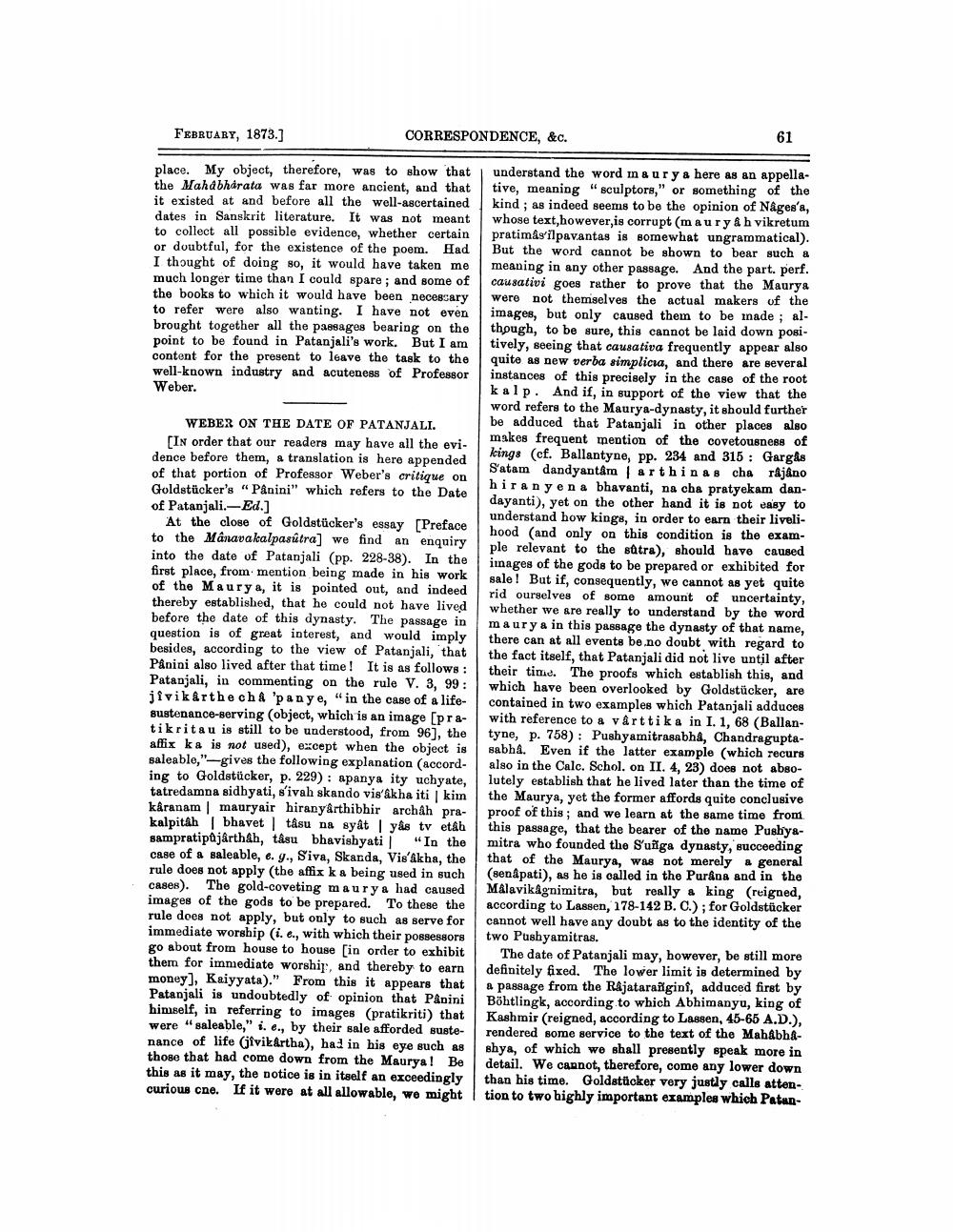________________
FEBRUARY, 1873.]
CORRESPONDENCE, &c.
place. My object, therefore, was to show that the Mahabharata was far more ancient, and that it existed at and before all the well-ascertained dates in Sanskrit literature. It was not meant to collect all possible evidence, whether certain or doubtful, for the existence of the poem. Had I thought of doing so, it would have taken me much longer time than I could spare, and some of the books to which it would have been necessary to refer were also wanting. I have not even brought together all the passages bearing on the point to be found in Patanjali's work. But I am content for the present to leave the task to the well-known industry and acuteness of Professor Weber.
WEBER ON THE DATE OF PATANJALI. [In order that our readers may have all the evidence before them, a translation is here appended of that portion of Professor Weber's critique on Goldstücker's "Panini" which refers to the Date of Patanjali.-Ed.]
At the close of Goldstücker's essay [Preface to the Mänavakalpasútra] we find an enquiry into the date of Patanjali (pp. 228-38). In the first place, from mention being made in his work of the Maurya, it is pointed out, and indeed thereby established, that he could not have lived before the date of this dynasty. The passage in question is of great interest, and would imply besides, according to the view of Patanjali, that Pånini also lived after that time! It is as follows: Patanjali, in commenting on the rule V. 3, 99: jivikarthech & 'panye, "in the case of a lifesustenance-serving (object, which is an image (pratikrita u is still to be understood, from 96), the affix ka is not used), except when the object is saleable,"-gives the following explanation (according to Goldstücker, p. 229): apanya ity uchyate, tatredamna sidhyati, s'ivah skando vis'&kha itikim kâranam mauryair hiranyarthibhir arch&h prakalpitah | bhavet tasu na syat | yâs tv etab sampratipujárth&h, tåsu bhavishyati "In the case of a saleable, e. y., Siva, Skanda, Visakha, the rule does not apply the affix k a being used in such cases). The gold-coveting maury a had caused images of the gods to be prepared. To these the rule does not apply, but only to such as serve for immediato worship (i. e., with which their possessors go about from house to house [in order to exhibit them for immediate worship, and thereby to earn money], Kaiyyata)." From this it appears that Patanjali is undoubtedly of opinion that Panini himself, in referring to images (pratikriti) that were "saleable," i. e., by their sale afforded sustenance of life (jivikArtha), had in his eye such as those that had come down from the Maurya! Be this as it may, the notice is in itself an exceedingly curious cne. If it were at all allowable, we might
understand the word maury a here as an appellative, meaning "sculptors," or something of the kind; as indeed seems to be the opinion of Någes', whose text, however,is corrupt (maury & h vikretum pratimas'ilpavantas is somewhat ungrammatical). But the word cannot be shown to bear such a meaning in any other passage. And the part. perf. causativi goes rather to prove that the Maurya were not themselves the actual makers of the images, but only caused them to be made ; although, to be sure, this cannot be laid down positively, seeing that causativa frequently appear also quite as new verba simplicia, and there are several instances of this precisely in the case of the root kalp. And if, in support of the view that the word refers to the Maurya-dynasty, it should further be adduced that Patanjali in other places also makes frequent mention of the covetousness of leings (cf. Ballantyne, pp. 234 and 315 : Gargas Satam dandyantâm | arthinae cha rájáno hiran y en a bhavanti, na cha pratyekam dandayanti), yet on the other hand it is not easy to understand how kings, in order to earn their livelihood and only on this condition is the example relevant to the shtra), should have caused inages of the kods to be prepared or exhibited for sale! But if, consequently, we cannot as yet quite rid ourselves of some amount of uncertainty, whether we are really to understand by the word maurya in this passage the dynasty of that name, there can at all events be no doubt with regard to the fact itself, that Patanjali did not live until after their time. The proofs which establish this, and which have been overlooked by Goldstücker, are contained in two examples which Patanjali adduces with reference to & vârttika in I. 1, 68 (Ballantyne, p. 758): Pushyamitrasabha, Chandraguptasabha. Even if the latter example (which recurs also in the Calc. Schol. on II. 4, 23) does not absolutely establish that he lived later than the time of the Maurya, yet the former affords quite conclusive proof of this; and we learn at the same time from this passage, that the bearer of the name Pushy&mitra who founded the Sunga dynasty, succeeding that of the Maurya, was not merely a general (senapati), as he is called in the Purana and in the Malavikagnimitra, but really & king (reigned, according to Lassen, 178-142 B. C.); for Goldstücker cannot well have any doubt as to the identity of the two Pushyamitras.
The date of Patanjali may, however, be still more definitely fixed. The lower limit is determined by a passage from the Rajatarailgini, adduced first by Böhtlingk, according to which Abhimanyu, king of Kashmir (reigned, according to Lassen, 45-65 A.D.), rendered some service to the text of the Mahabhashya, of which we shall presently speak more in detail. We cannot, therefore, come any lower down than his time. Goldstücker very justly calls attention to two highly important examples which Patan




